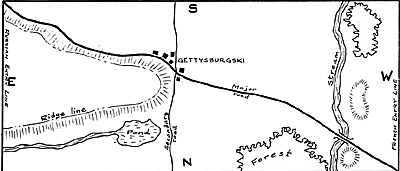 The entire idea behind the scenario of Gettysburgski was to deal with one
aspect of the "fog of war": not always having the ideal force, balanced, forces,
or perfect intelligence of the enemy. "Fog" also includes bad communications,
missing communications, pig-headedness, in short why generals occasionally
feel steam-rolled by events.
The entire idea behind the scenario of Gettysburgski was to deal with one
aspect of the "fog of war": not always having the ideal force, balanced, forces,
or perfect intelligence of the enemy. "Fog" also includes bad communications,
missing communications, pig-headedness, in short why generals occasionally
feel steam-rolled by events.
The small town of Gettysburgski came to have a deserved place in history among the members of the Colonial Williamsburg Simulations Club. The scenario itself was drawn from the events of 1 July 1863, during the American Civil War. However, these conditions were used in a Napoleonic setting, in order to condition club members for a later (1813) campaign.
The town and surrounding area for Gettysburgski was laid out on a 6'x9, table with 15mm French and Russian Napoleonic figures, using the Garde du Corps rules by R.S. Nelson. Tape provided the roads, HO scale trees the woods and so on. Explaining the scenario to the players took approximately 15 minutes.
Each player started out with equal forces of 1 cavalry regt. (light cavalry only) per player.
As it worked out, there were two players per side so this did not result in one side being out-scouted. There was one command figure per side to establish control over incoming units and entering units had to pass within 5" of the figure to avoid penalties.
Die Roll (unless pass within 5" of command figure)
- 1 charge nearest enemy regardless of circumstances
2 retreat towards nearest friendly unit immediately
3 remove unit from table and thus battle
4 stand in place
5 out of control, roll every turn following on this table
6 do exactly what is best for your side, from any entry point
Individual commanders were responsible for where troops entered on their respective sides of the table. The French entering from the west, the Russians from the east. Victory conditions for both sides were possession of the hamlet of Gettysburgski and the bridge, or concession by one side, or one side destroyed/forced off-table. New units were rolled for each turn:
Die Unit
- 1 1 cavalry regt. (type players choice)
2 2 cavalry regts. (one must be dragoons)
3 2 cavalry, (one dragoons), 1 horse battery
4 1 inf. regt., 1 foot battery
5 1 cavalry regt., 1 horse battery, 2 inf. regts., 1 foot battery
6 1 brigade/division of inf., 1 foot battery
Simulation Club members Don Shimek, Rich Villella, Larry Fulton, and Jon Spoor faced off. Don and Jon took the Russians, and Rich and Larry the French. The author was referee.
The Russians immediately seized control of Gettysburgski, after the first turn when both sides entered onto the table. Several turns followed before anybody could buy six feet of Russian soil. The Russians established their line along the N/S secondary road, with cavalry and artillery on the ridge, and Pavlov Grenadiers in the houses. The French forces began grouping behind the N/S streambed.
General action began as the French crossed the stream at several points. Cavalry melee flowed back and forth, with the Russians receiving the bulk of the losing rolls. However, they valiantly hung on, establishing another headquarters to control the right flank.
Both sides had not rolled a six, nor had the infantry got into the fight. However, the Russian Marshal must have been near the path of the Grand Armee, for the French now rolled a six (one disaster for the Russians) and another six the following turn (final disaster). The Russian Marshal handed in his sabre. The Russians still held the town, but wouldn't have for long, especially when the dice were against them.
The general club concensus was that this was a good scenario. While probably not a completely original solution to the "fog of war" problem, the players adapted to the element of surprise quickly, while maintaining the game atmosphere preferred. The Garde du Corps rules has since become the house Napoleonic rules for 15mm.
There is a small town on the veldt named Gettysburgski that the Zulus want and the British have...
ED NOTE: I would like to see this tried using percentage (2d10) dice used for troop entry with varying chances for each force entry. Perhaps different chance factors for each side could be used.
Back to Table of Contents -- Courier Vol. VII #6
To Courier List of Issues
To MagWeb Master Magazine List
© Copyright 1987 by The Courier Publishing Company.
This article appears in MagWeb (Magazine Web) on the Internet World Wide Web.
Other military history articles and gaming articles are available at http://www.magweb.com